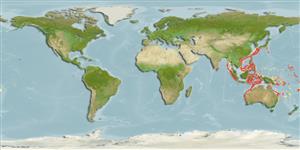Teleostei (teleosts) >
Dactylopteriformes (Flying gurnards) >
Dactylopteridae (Flying gurnards)
Etymology: Dactyloptena: Greek, daktylos = fingers + Greek, pten, -enos = wing, fin; tiltoni: Named for Thomas Tilton.
Eponymy: Thomas Tilton was a benefactor of ichthyological research undertaken by the Californian Academy of Sciences. [...] (Ref. 128868), visit book page.
Environment: milieu / climate zone / depth range / distribution range
Ecology
Marine; bathydemersal; depth range 119 - 565 m (Ref. 27821). Deep-water
Western Pacific: Western Australia and the Philippines.
Size / Weight / Age
Maturity: Lm ? range ? - ? cm
Max length : 9.5 cm SL male/unsexed; (Ref. 27821)
Found on the continental shelf. Benthic (Ref. 75154).
Life cycle and mating behavior
Maturity | Reproduction | Spawning | Eggs | Fecundity | Larvae
Eschmeyer, W.N., 1997. A new species of dactylopteridae (Pisces) from the Philippines and Australia, with a brief synopsis of the family. Bull. Mar. sci. 60(3):727-738. (Ref. 27821)
IUCN Red List Status (Ref. 130435: Version 2025-1)
Threat to humans
Harmless
Human uses
Tools
Special reports
Download XML
Internet sources
Estimates based on models
Preferred temperature (Ref.
123201): 10.7 - 19.8, mean 14.2 °C (based on 208 cells).
Phylogenetic diversity index (Ref.
82804): PD
50 = 0.5235 [Uniqueness, from 0.5 = low to 2.0 = high].
Bayesian length-weight: a=0.00550 (0.00229 - 0.01319), b=3.09 (2.88 - 3.30), in cm total length, based on LWR estimates for this (Sub)family-body shape (Ref.
93245).
Trophic level (Ref.
69278): 3.4 ±0.5 se; based on size and trophs of closest relatives
Resilience (Ref.
120179): High, minimum population doubling time less than 15 months (Preliminary K or Fecundity.).
Fishing Vulnerability (Ref.
59153): Low vulnerability (10 of 100).
🛈
